Between the Stitches: Embroidery Techniques in Dragons on the Tibetan Plateau
15 January 2021
How can textiles tell a story?
In Dragons on the Tibetan Plateau: Selected Textiles from the Mactaggart Art Collection colours and symbols on textiles provide insight into the historic cultural exchange between Tibet and China; but, what insight can be learned from how these patterns were created on Chinese silks? Embroidery is one pattern-making technique exemplified in this exhibition that illustrates how advanced the craft had become in China by the Ming (1368-1644) and Qing (1644-1911) dynasties. Between the stitches, this embroidery provides insight into the history, expertise, and techniques that are still practised and appreciated today.
Embroidery Examples in Dragons on the Tibetan Plateau
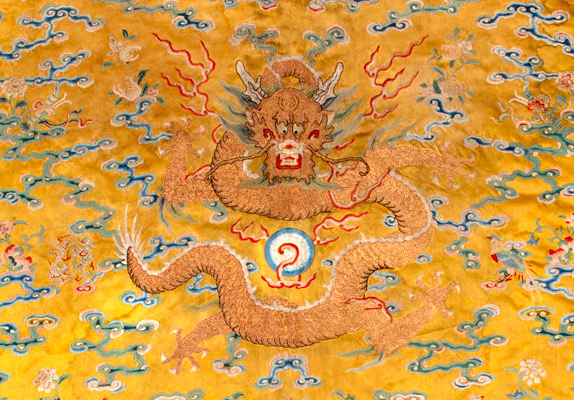 .
. 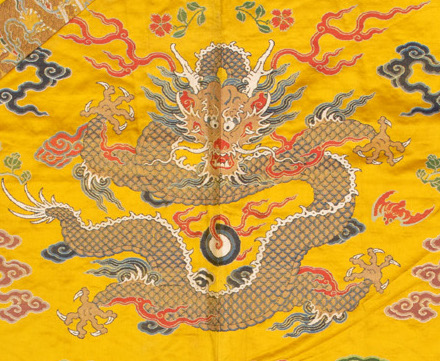
Embroidery is a technique applied to the surface of a finished textile to create a design. Traditionally done by hand, it involves using needles, multi-coloured threads, and a variety of different stitch types to create varied surface designs and effects. Embroidery can create exceptionally intricate patterns but, especially with large projects, can take a long time to complete. In China, the history of silk embroidery dates back thousands of years. Over time four distinct styles of silk embroidery emerged, each with its own distinct style and reputation: Shu, Xiang, Suzhou, and Yue.
While Tibet had their own vibrant and unique styles of embroidery, at that time there was an appreciation for high-quality Chinese silks that were frequently exchanged as gifts. Textiles in the Dragons on the Tibetan Plateau exhibition were fashioned from silks that featured revered Chinese embroidery techniques and auspicious symbols that held meaning in both cultures.
In the Dragons on the Tibetan Plateau exhibition "Yellow Silk Tibetan Chuba" (2005.5.269) shows an embroidered five-claw dragon pattern and the 12 Symbols of Imperial Rule.
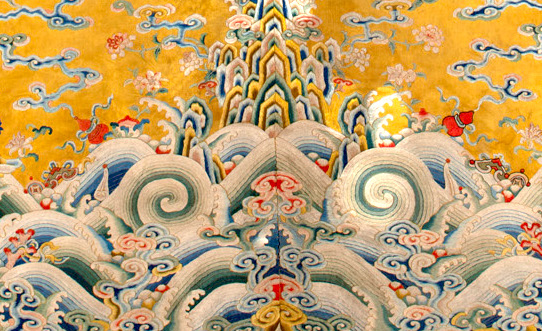 .
. 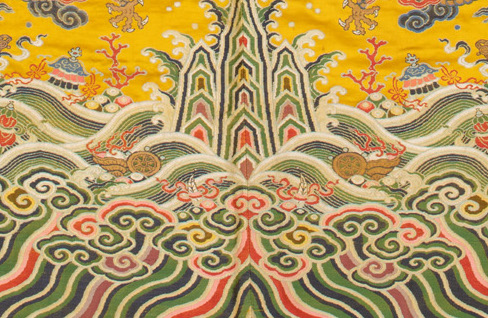
On the textile “Yellow Silk Tibetan Chuba,” Suzhou embroidery techniques are used to create patterns and imagery that appear smooth, shiny, and to have depth. The dragon’s body shows a variety of blended metallic threads and shades of yellow-gold to create a body with dimension. The shiny and smooth finish comes from using long satin stitches of fine untwisted silk thread, which reflects light more evenly than twisted thread. These characteristics of embroidery also help create a sense of movement in patterns, which can be seen in the clouds surrounding the dragon bodies and in the rolling, spiralled waves at the hem. When compared with a similar Tibetan chuba from the Mactaggart Art Collection that uses brocade weaving techniques to create dragon patterns, the effects of Suzhou embroidery stand out. These patterns and textiles were all hand-stitched, which would have likely taken even the most skilled embroidery artist months or years to finish. Find more examples of embroidery in the Mactaggart Art Collection here.
What is Suzhou Embroidery?
Suzhou embroidery is one of the most celebrated styles of Chinese silk embroidery. Suzhou embroidery dates back more than 2,000 years, named for the city of Suzhou in the Jiangsu province of China. During the Ming and Qing dynasties, this style of embroidery was revered and in high demand, especially from the Imperial family. Known for its meticulous detail, a smooth finish, the finest materials, and requiring decades of time to master, this style of embroidery earned a prestigious reputation that has endured for centuries.
In order to achieve great levels of detail, realism, and a smooth finish, Suzhou artisans used more than 1,000 different types of thread in varying increments of colour, widths, and sizes. Some needles were the size of human hair to accommodate thinly split threads.
Embroidery Today
Representing a long history and meticulous craftsmanship, embroidery techniques add to the story told by the textiles in Dragons on the Tibetan Plateau. Embroidery is still practised today both by hand and by machine and valued as a cultural craft.
It might take years to master the specific Suzhou embroidery seen in the exhibition, but you can try embroidery stitches at home with a few basic craft materials. Try learning how to embroider a lotus flower pattern from the exhibition here.
The virtual reality tour Dragons on the Tibetan Plateau: Selected Textiles from the Mactaggart Art Collection can be viewed here.
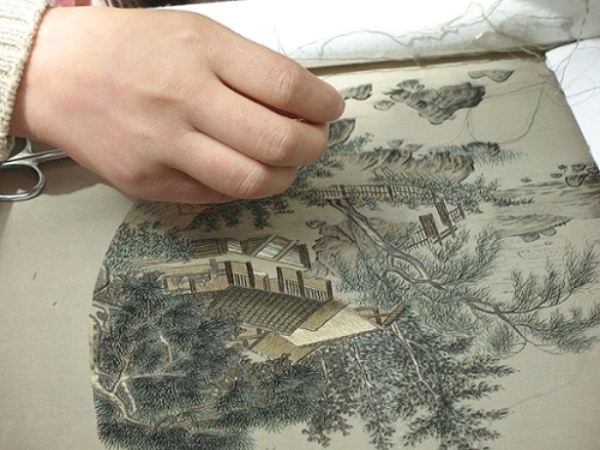
Sources
What is Su Embroidery? The History of Suzhou Silk Embroidery Art
Image Credits
Left Embroidered Dragon and Waves: Details from “Yellow Silk Tibetan Chuba,” date unknown; yellow silk satin embroidered with silk and metal-wrapped threads; Mactaggart Art Collection; University of Alberta Museums; Gift of Sandy and Cécile Mactaggart; 2005.5.269
Right Woven Dragon and Waves: Details from “Yellow Silk Brocade Tibetan Chuba,” date unknown; yellow silk satin brocaded with silk and metal-wrapped; Mactaggart Art Collection; University of Alberta Museums; Gift of Sandy and Cécile Mactaggart; 2005.5.101
Video: "Su Embroidery" by Smithsonian Folklife on Youtube.
“Gu Embroidery from Suzhou family,” by Gary Soup is licensed under CC BY 2.0